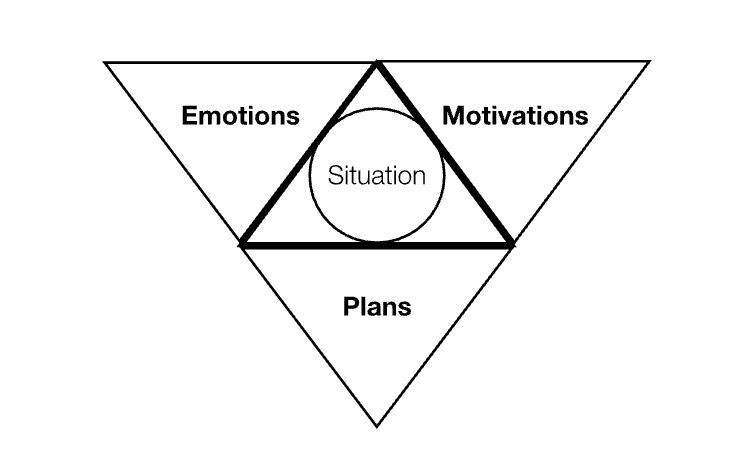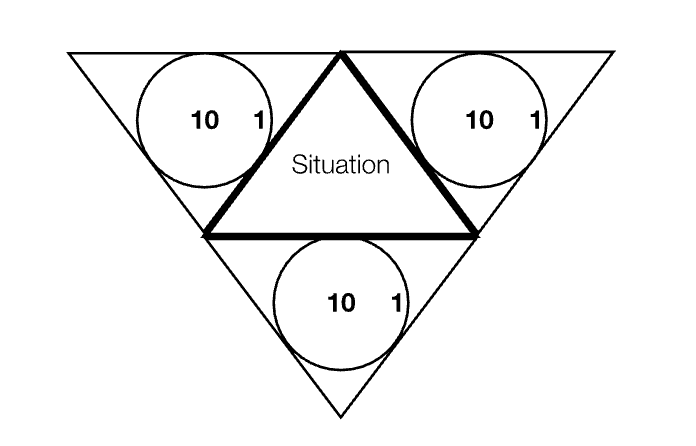The Wise Other You’re Looking For Might Be Inside You (Part 2)

How Using CoreSelf Mapping and AI as Mirror Can Calm the Mind and Clarify What Matters
Where Am I Stuck?
The Internal Map That Calms Your Mind and Clarifies What Matters
Part 2 of the CoreSelf Mapping Series
We all get stuck.
But what’s less obvious is where we’re stuck, especially in the middle of a high-stakes situation or emotional storm.
Sometimes we say:
• “I feel overwhelmed.”
• “I don’t know what to do next.”
• “I can’t tell if this is even worth it.”
But stuckness is rarely general.
It usually comes down to a specific situation and one of three specific blocks: emotional, motivational, or directional.
That’s where CoreSelf Mapping (CSM) comes in.
It’s not just a reflective tool.
It’s a way to understand where you are, what part of your mind feels stuck, and how to reconnect to your own energy, values, and direction.
The CoreSelf Pyramid: A 2D Map of a 3D Mind
Let’s start with a simple diagram.
Imagine a 2D triangle lying flat. At the center is a specific moment or challenge you’re navigating.

Connected to this central triangle are three sides, each representing a facet of being stuck:
1. Emotions / Sensations
You feel critical (of yourself or others), vulnerable (hurt, sad, lonely, scared), rescuing (overextending to help others), or escaping (checking out or rebelling).
These emotions often drain energy and cloud perception, especially when we can’t name or sort them.
2. Motivations / Practices
You’re caught in the expectations of others or yourself, and that creates tension.
Sometimes you’re misaligned with your core values.
Other times, you’re doing what you should instead of what you believe in, especially at work or in close relationships.
3. Directions / Plans
You’re overwhelmed.
Your brain may be in fight-or-flight, you don’t see any clear options, or you’re under so much pressure that your choices feel random or reactive, like turning to alcohol, gambling, or shutting down completely.
Each Facet Has Its Own Compass

On each side of the pyramid is a circle with a 1–10 scale; this represents your current emotional energy:
• 1 is the Rim: reactive, drained, tense
• 10 is the Core: calm, energized, centered
Ask yourself:
• Where am I right now (on this facet)?
• Where do I want to be?
This creates a moment of metacognition, a brief pause where you can observe your experience instead of being consumed by it.
Research shows that even this small act of numbering (not naming) emotions can reduce emotional intensity and improve regulation (Barrett, 2017).
Folding It All Together: The 3D Perspective

Now fold the pyramid upward.
What were once flat sides become walls of a three-dimensional space.
And within that space, you notice something important:
Each of those circles wasn’t isolated.
They were all views of the same 3D sphere, a central awareness that sees every facet at once.
That sphere is your Internal Observer.
It’s the part of your mind that monitors emotional energy, motivation, and direction simultaneously, helping to bring your energy back to the Core.
CSM + AI: A Partnership, Not a Competition
In high-pressure moments, many people seek external guidance: mentors, tools, AI.
In fact, a recent Harvard Business Review (2025) study found the #1 use of AI is companionship and therapy, not productivity.
This reveals a deep truth:
People aren’t just looking for answers. They’re looking to be seen, supported, and centered.
That’s why CoreSelf Mapping (CSM) and AI are such powerful partners.
CSM monitors your internal energy and helps you align it to take actionable next steps.
AI offers external reflection: providing language, insights, and reminders.
Together, they help you reconnect your situation to your capacity.
“You’re not competing with AI. You’re partnering with it to create deeper human insight and alignment.”
—Partnership Framing, CoreSelf Positioning
Mental Maps Are Real and Powerful
When you use CoreSelf Mapping to simulate choices or test scenarios internally, your brain doesn’t distinguish that from a real experience.
This is thanks to John O’Keefe and the Mosers’ Nobel-winning work on place cells and grid cells showing that our brains build internal cognitive maps to simulate and plan action (O’Keefe & Nadel, 1978).
Similarly, the article “The Brain’s Social Road Maps” in Scientific American (2020) explains how we mentally map not only places but people, relationships, and decisions.
That means CSM creates not just insight but new experience.
It gives your brain a safe way to rehearse reality, and store new options for future recall.
Summary: When You Feel Stuck, Use the Pyramid
If you’re overwhelmed, reactive, or out of options:
• Start with a single, specific situation
• Use the 3-sided pyramid to identify which facet you’re stuck in
• Rate yourself (1–10) on that facet’s circle
• Ask: Where am I? Where do I want to be?
• Let your Internal Observer, and external partners like AI, support you in returning to your Core
What’s Next?
In Part 3 of this series, we’ll go deeper into each facet of the pyramid, and explore how to use CSM and its sister framework, CoreSelf Positioning (CSP), to navigate both personal and professional challenges.
In the meantime, if this article sparked something in you:
Explore the book: CoreSelf Positioning
Suggested Reading
- Barrett, L. F. (2017). How Emotions Are Made: The Secret Life of the Brain
- The Brain’s Social Road Maps, Scientific American, Vol. 322, Issue 2, pp. 30–35 (Feb 2020), Matthew Schafer, Daniela Schiller
- Preston, T., & Thomas, J. (2025). CoreSelf Positioning: Getting on the Same Page, Literally. Amplify Publishing.
• Doty, J. R. (2023). Mind Magic: The Neuroscience of Personal Transformation
• O’Keefe, J., & Nadel, L. (1978). The Hippocampus as a Cognitive Map
• Hilgard, E. R. (1977). Divided Consciousness and the Hidden Observer
• James, W. (1890). The Principles of Psychology
About the Authors
Jonathan Thomas, MSW
Whether at the potter's wheel, coaching medical professionals and teams, or in his private counseling practice, Jonathan Thomas has spent his life molding, shaping and creating something beautiful and new.
Tim Preston
As a successful serial-entrepreneur and angel investor, Tim Preston has spent the majority of his life learning, overcoming, and creating, from blank pieces of paper: self, spaces, teams, and businesses.
Together, Jonathan and Tim founded Simple. Not Easy., LLC, a company that developed CoreSelf Positioning™ tools to help companies and individuals to slow down and align energy levels, values, and actions in order to formulate their best next steps.
Learn more about Jonathan, Tim & CoreSelf Positioning.